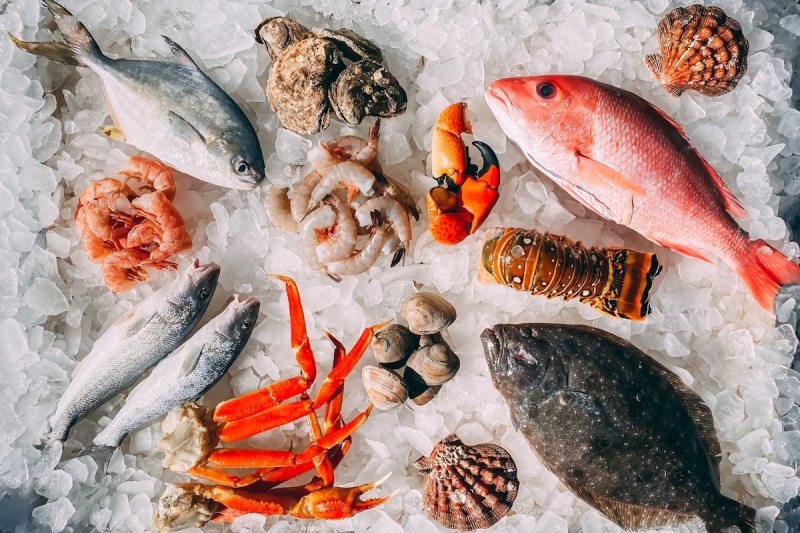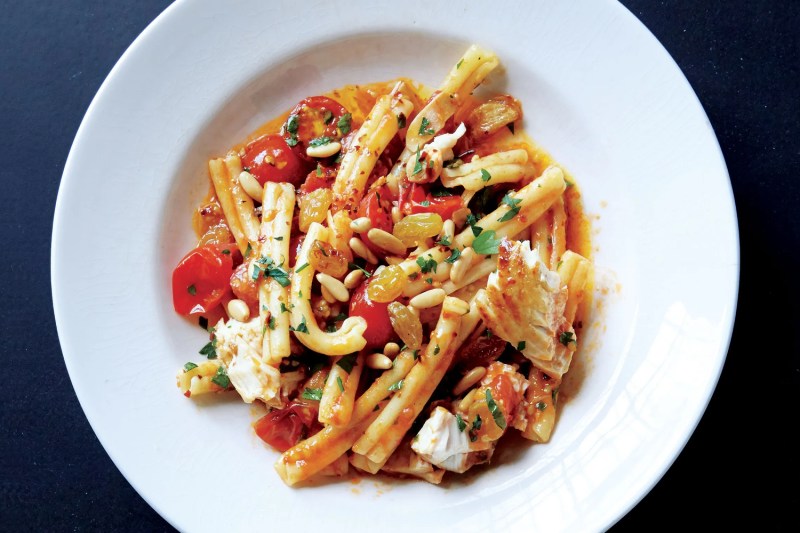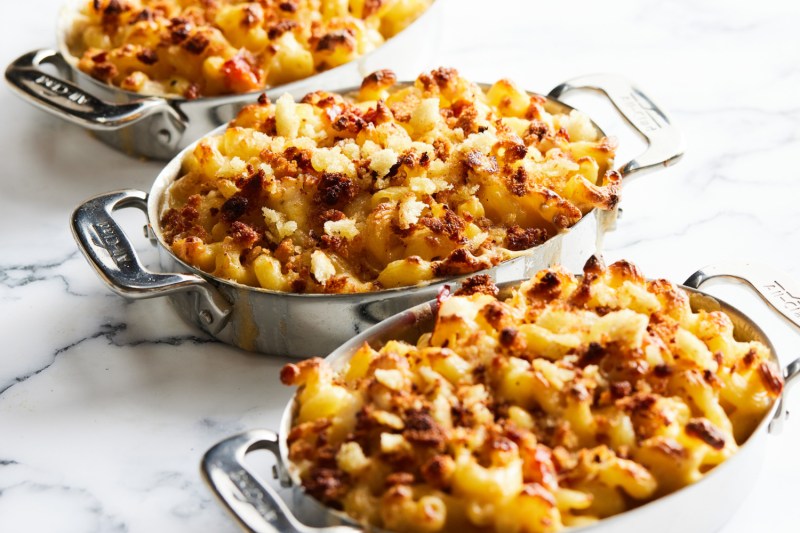As winter sets in, our stomachs ache for things like stews, cheeses, hot cocktails, and holiday cookies. And while there are plenty of great things to enjoy on land this time of year, it’s easy to overlook the many fresh ingredients being plucked from the ocean. It’s seafood pasta season, people; get with the program and start enjoying.
Many of the best and most pasta-friendly ocean edibles are in peak season now through the winter. Despite shortages in crab in some places, we’re still set to enjoy some peak seafood season in the months to come. And we’ll guide you with some tips and a few great recipes.

So as you look to dine in style this holiday season and impress guests with thoughtful cuisine, consider the following exceptional seafood pasta dishes.
What’s in season right now?
Rockfish: This fish, often called striped bass, comes in fresh throughout the winter and is an excellent option for a host of tasty seasonal recipes.
Shellfish: Certain crab species are headed into prime time right now, as well as delicacies like oysters, scallops, mussels, and more.
Salmon: Many salmon runs happen in the summer, but other places, like Alaska, get wild species like King Salmon through the winter months.
Triggerfish: The season for this fish, at least in the Gulf Coast, usually starts right around the new year. They offer a nice sweet flavor and pan fry up delightfully.
Monkfish: Another species that’s fished all year but seems to taste better when the water is nice and cold, like right about now.
Keep in mind it all depends on where it’s coming from. The above generally concerns U.S. coastal waters. In places like the Mediterranean, you can eat fresh or sustainably-caught anchovies, mackerel, cuttlefish, sole, octopus, sea bass, and more in the winter.
What about shrimp?
It’s technically the offseason for shrimp, but that doesn’t mean you can’t still enjoy it. Much of what you’ll find is frozen, but you can navigate that too. Check out the labels to see if the shrimp are frozen both once they’re caught and again during processing. If you can find an option that tends to freeze just a single time (Del Pacifico, for example), you’ll end up with a better-tasting crustacean.
When purchasing, don’t overdo it. It’s tough to hold on to shrimp, and if you have to refreeze, the flavors won’t always be as good (nor the consistency). Look for fair-trade and sustainable options as you work your way through the store and think about the end game. If you’re going with shrimp cocktail, order with heads intact as the presentation is better. For most other dishes, the heads are unnecessary.
Don’t overcook! You’ll want to maintain most of that shrimp hue, so be sure not to cook the so long they become pale. A great way to know, more or less, is by remembering the following: If they’re in a “C” shape, they’re properly cooked, if they curl all the way into an “O” shape, they’re likely overcooked.
Pasta with swordfish and cherry tomato sauce

This recipe from Bon Appétit is easy to make and delectable. It’s prime time for swordfish in much of the North Atlantic right now as well.
Prep Time: 30 minutes
Total Time: 30 minutes
Yield: 4 servings
Ingredients
- 3 tablespoons olive oil, divided
- 4 oil-packed anchovy fillets
- 4 garlic cloves, sliced
- 1/2 teaspoon crushed red pepper flakes
- 2 pints cherry tomatoes, halved
- Kosher salt and freshly ground black pepper
- 1 pound 1-inch-thick swordfish steaks
- 2 tablespoons pine nuts
- 12 ounces casarecce or other short pasta
- 1/2 cup chopped fresh parsley, divided
- 2 tablespoons golden raisins
Method
- Heat 2 tbsp. oil in a large skillet over medium. Cook anchovies, garlic, and red pepper flakes, stirring occasionally, until anchovies disintegrate, about 3 minutes. Add half of tomatoes; season with salt and pepper. Cook, stirring occasionally, until sauce thickens, 12–15 minutes. Add remaining tomatoes; remove from heat.Meanwhile, heat remaining 1 tbsp. oil in a large skillet over medium-high. Season fish with salt and pepper and cook until golden brown and just cooked through, about 4 minutes per side. Let cool slightly. Coarsely flake flesh; discard skin.
- Toast nuts in a dry small skillet over medium-low heat, tossing often, until golden brown, about 4 minutes. Let cool.
- Cook pasta in a large pot of boiling salted water, stirring occasionally, until al dente. Drain, reserving 1 cup pasta cooking liquid.
- Add pasta and ½ cup pasta cooking liquid to tomato sauce and cook over low heat, tossing often and adding more cooking liquid as needed, until sauce is thickened and coats pasta. Add fish to pasta along with half of parsley and toss once to combine.
- Serve pasta topped with raisins, pine nuts, and remaining parsley.
Creamy Bay Scallop Spaghetti
Bay scallops tend to really come online November through March, so now’s a great time to whip up this winter-made pasta dish. This recipe from allrecipes is worth trying out at home.
Prep Time: 10 minutes
Total Time: 30 minutes
Yield: 4 servings
Ingredients
- 8 ounces uncooked thick spaghetti
- 1 tablespoon vegetable oil
- 1 pound bay scallops
- 2 tablespoons butter
- 3 cloves garlic, minced
- 2 teaspoons grated lemon zest
- 1 pinch red pepper flakes
- 1/3 cup dry sherry
- 1 cup heavy cream
- salt and pepper to taste
- 1 lemon, juiced
- 2 tablespoons chopped Italian parsley, divided
- Freshly grated Parmigiano-Reggiano cheese, for serving
Method
- Bring a large pot of lightly salted water to a boil. Cook spaghetti in the boiling water, stirring occasionally until tender yet firm to the bite, about 10 minutes or 1 minute less than directed on the package.
- Meanwhile, heat oil in a large skillet over high heat. When oil just starts to smoke, add scallops and move them into a single layer. Let sear on high for about 1 minute. Toss to turn. Add butter and stir scallops until butter melts. Stir in garlic. Add lemon zest and red pepper flakes. Stir in sherry and cook and stir until alcohol cooks off, about 1 minute. Pour in cream. When mixture begins to simmer, reduce heat to medium-low. Add salt, pepper, and lemon juice.
- Drain pasta. Transfer to skillet with scallops; bring to a simmer. Add 1/2 of the chopped parsley. Cook until pasta is heated through and tender, about 1 minute. Remove from heat. Garnish generously with grated cheese. Add the rest of the parsley. Serve in warm bowls.
Lobster Mac

What’s more decadent and filling than lobster mac? Nothing, said everyone. Here’s a great riff courtesy of the Food Network. Oh, and it’s great with Champagne.
Prep Time: 15 minutes
Total Time: 85 minutes
Yield: 6-8 servings
Ingredients
- Kosher salt
- Vegetable oil
- 1 pound cavatappi or elbow macaroni
- 1 quart milk
- 8 tablespoons (1 stick) unsalted butter, divided
- 1/2 cup all-purpose flour
- 12 ounces Gruyere cheese, grated (4 cups)
- 8 ounces extra-sharp Cheddar, grated (2 cups)
- 1/2 teaspoon freshly ground black pepper
- 1/2 teaspoon nutmeg
- 1 1/2 pounds cooked lobster meat
- 1 1/2 cups fresh white bread crumbs (5 slices, crusts removed)
Method
- Preheat the oven to 375 degrees F.
- Drizzle oil into a large pot of boiling salted water. Add the pasta and cook according to the directions on the package, 6 to 8 minutes. Drain well.
- Meanwhile, heat the milk in a small saucepan, but don’t boil it. In a large pot, melt 6 tablespoons of butter and add the flour. Cook over low heat for 2 minutes, stirring with a whisk. Still whisking, add the hot milk and cook for a minute or two more, until thickened and smooth. Off the heat, add the Gruyere, Cheddar, 1 tablespoon salt, the pepper, and nutmeg. Add the cooked macaroni and lobster and stir well. Place the mixture in 6 to 8 individual gratin dishes.
- Melt the remaining 2 tablespoons of butter, combine them with the fresh bread crumbs, and sprinkle on the top. Bake for 30 to 35 minutes, or until the sauce is bubbly and the macaroni is browned on the top.
Monkfish
Winter is the best time for monkfish, so collect some from your local fishmonger or seafood counter and get to work on this recipe from Food from Portugal.
Prep Time: 15 minutes
Total Time: 65 minutes
Yield: 4 servings
Ingredients
- 1 3/4 pounds monkfish
- 14 ounces shrimp
- 10 1/2 ounces elbow pasta
- 3 cloves of garlic
- 1 large onion
- 1/4 cup olive oil
- 2 medium ripe tomatoes
- Coriander and salt to taste
Method
- Place the monkfish in a saucepan with water seasoned with salt. Bring to a boil over high heat, then reduce to low heat and cook about 20 to 25 minutes. When the monkfish is cooked, drain it, remove the skin and the bones and cut the fish in pieces; set aside.
- Place the shrimps in another saucepan with about 4 cups water and boil over high heat. When starts boiling, reduce to low heat and cook for 5 minutes. When the shrimps are cooked, drain with a skimmer and place on a plate. Allow to cool slightly and peel them. Reserve about 2 cups of the cooking water.
- In a saucepan, place the chopped onion, the chopped garlic and the olive oil. Stir and saute over low heat until the onion starts to turn golden brown. Add the peeled tomatoes cut into small pieces and cook until the tomatoes start to break down, stirring occasionally. Then, pour the shrimp cooking water seasoned with a little salt and boil over medium-high heat. When starts boiling, reduce to medium-low heat, add the pasta and simmer about 8 to 10 minutes.
- When the pasta is almost cooked, add the monkfish and the peeled shrimps, stir and turn off the heat. Sprinkle with chopped coriander and serve.


